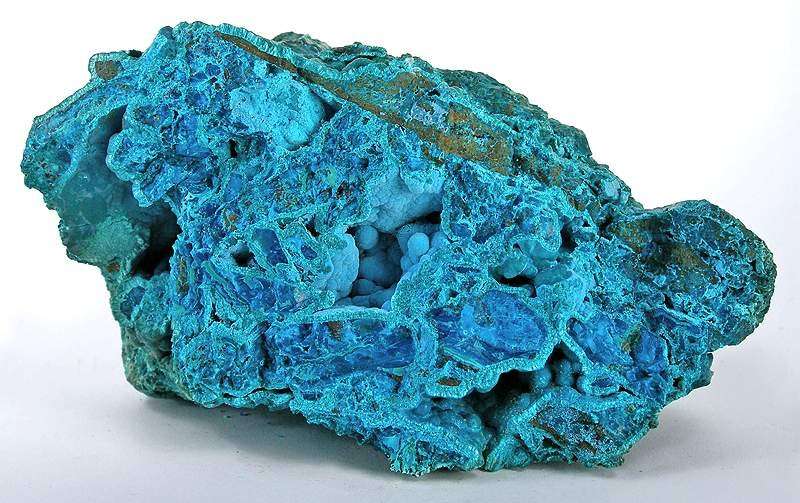
Appearance
It displays a multitude of hues, such as turquoise, green, blue, and even black or brown. Frequently, the colors are banded or mottled. Its luster ranges from vitreous to dull, depending on the specimen and the features of its surface. It usually varies in transparency from translucent to opaque. It doesn’t produce distinct crystal formations when it crystallizes. Rather, it typically manifests as fibrous or vein-like structures, as well as amorphous or botryoidal masses.
Geographical Distribution
Worldwide, deposits of chrysocolla are found in a number of locations. Arizona, the United States, the Democratic Republic of the Congo (DRC), Peru, Australia, and Mexico are a few of the main deposit places.
History
Greek philosopher and botanist Theophrastus originally referred to the stone as chrysocolla in 315 B.C. The phrase was formed from the Greek words chrysos, which means gold, and kola, which means glue. This alludes to the fact that goldsmiths have used chrysocolla as an element in solder, known as santerna to the Romans, since ancient times in order to fuse gold pieces together. Many artists have been inspired by this colorful gemstone, from Renaissance painters who ground it into paint pigment to modern jewelry designers who incorporated it into their creations. Ancient goldsmiths used it as solder.
Metaphysical Properties
Thought to possess a number of metaphysical qualities, such as fostering empowerment, communication, and emotional harmony. It is said to support self-expression and creativity and is frequently connected to the throat chakra. The mystical qualities of gemstones, however, are purely arbitrary and unproven by science.

Chemical Composition
Its precise chemical constituents can vary, giving it a complicated composition. Its chemical formula, which is frequently written as (Cu,Al)2H2Si2O5(OH)4·nH2O, indicates the presence of water molecules (H2O) as well as copper (Cu), aluminum (Al), silicon (Si), oxygen (O), and hydrogen (H).
Uses
- Indicator of Copper Mineralization: Important mineral for economic geology since it can show whether copper mineralization is present in a certain location. Its presence indicates the possibility of primary copper deposits nearby, as does the presence of other secondary copper minerals like azurite and malachite. Chrysocolla is a common indicator of copper mineralization, which geologists use to pinpoint locations and search for possible metal deposits.
- Geological Significance in Ore Deposits: Chrysocolla is not a significant copper ore mineral in and of itself, but its presence may be a clue that nearby primary copper resources exist. In the upper reaches of ore deposits, chrysocolla is formed as a secondary mineral as a result of primary copper minerals weathering and changing. As a result, its presence might reveal important details regarding a deposit’s possible mineralization zones, alteration processes, and geological history.
- Gemological and Ornamental Uses: Chrysocolla is a well-liked gemstone and ornamental material because of its eye-catching designs and vivid blue-green or green hues. It is frequently polished and carved into beads, cabochons, and other jewelry. When mixed with other copper minerals like malachite or azurite, chrysocolla’s distinctive colors and patterns result in aesthetically arresting gemstones and decorative items.
- Industrial Applications: Due to its softness and lack of toughness, it has few industrial applications. On occasion, though, it is employed in small-scale tasks like artistic projects, decorative carvings, and inlay work. Chrysocolla is also prized for its aesthetic value by lapidaries and collectors due to its appealing colors and patterns.
Table





